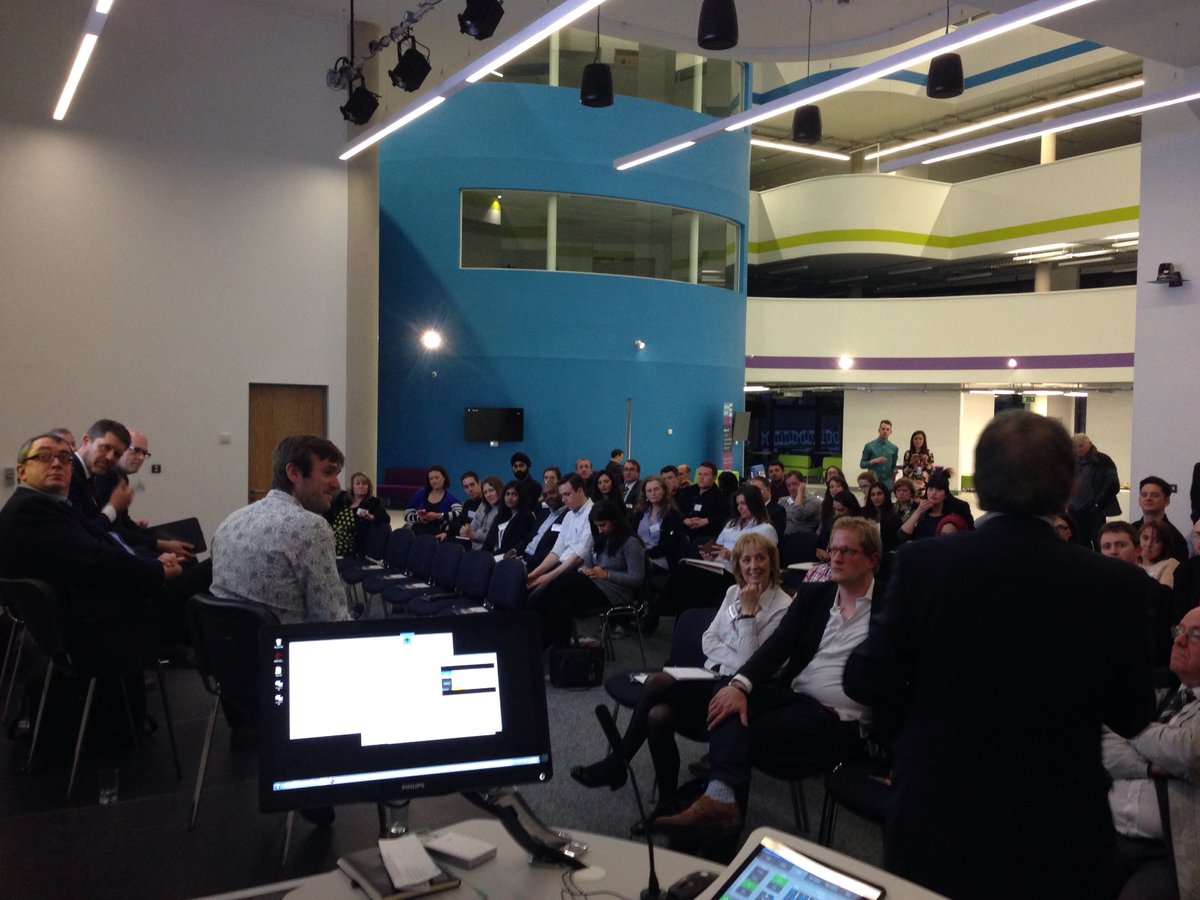Meet the Journalists Event
 |
| BrumBizRadio Twitter |
Five top journalists gave us top tips on how to maximise your chances of getting them to run a story about you or your company. The Enterprise Nation event at digital start-up specialists Innovation Birmingham focused on identifying the correct media to target, how to approach them with a relevant press release and how and when to send it.
The key is to approach the journalists when you have something that they (not you) think is newsworthy.
 |
| The plush new ICentrum building in Birmingham |
Tom's Top Tips
 |
| Tom Whipple Twitter |
Tom Whipple Science Editor of The Times
Tom stated that he is interested in stories that are related to his subject rather than your business success, contracts won or prizes etc. So your press release will need to have something exciting scientifically to catch his attention. A story he liked recently was about the train app that rail travellers use to tell each other how busy the train carriages are that they are travelling on.
Tom's preference is for stories to be around 500 to 600 words long. He also likes statistics behind websites for example the Okcupid dating website had interesting stats about the average age gap in relationships and popular keywords used in member profiles.
Steve likes to run a mixture of short stories and features in his Business Quarterly magazine and email newsletter. He prefers to focus on innovation and collaboration articles that look at the people behind the story and new jobs created.
Steve Dyson BQ Magazine
 |
| Steve Dyson Twitter |
Steve likes to run a mixture of short stories and features in his Business Quarterly magazine and email newsletter. He prefers to focus on innovation and collaboration articles that look at the people behind the story and new jobs created.
Steve also curates a daily newsletter and loves long term quality articles. A good question to ask yourself about the quality of your press releases is:
Will my story still be relevant in 3/6 months?
Steve does not like jargon and unlike many journalists is happier to be contacted by phone rather than email. You can also contact him with updates, progress and results of your story.

Kurt, like most journalists is a very busy man and you better get to the point when you approach him. No small talk, no 'how is your day?' as you only have ten seconds to pitch your story. Kurt has a fondness for stories of small companies taking on the big boys and is more accommodating about stories dealing with figures, profit and loss amounts, investment expenditure etc.
Kurt's key questions about running a story are:
What is the utility of this article?
What purpose does it serve my readers?
How does it help them knowing this?
Richard's key point was that as The Economist has two thirds of its readers from overseas your press release will need to have global relevance and interest. Richard travels often to visit sites to get real in-depth stories. He wants to know what makes you different?
3 tips to get Richard's attention
1) Trends: is your business involved in a new or developing trend?
2) Set-up: is your start-up arrangement new? How is what you are doing revolutionary?
3) Socio-political: does your story have relevance to larger political and social issues?
Duncan finds the social media platforms good for engagement but is also happy to be contacted by phone. He is more interested in your press release if you are creating jobs and is happy to meet you in person if it will improve the quality of the article. The Business Desk like to react quickly to stories with Duncan once publishing an article in 20 minutes after hearing from a source that a business was closing down.
Provide information not marketing.
Ask yourself should your press release be factual and to the point or contain deeper analysis to make it more interesting?
Who is your audience?
Who do you want to see your press release?
No blanket emails.
Many journalists will spot emails that have 100s of recipients and treat that email as junk. You should personalise your email to the journalist and their area of expertise.
The right journalist at the right time with the right content.
Have you researched who is most suitable to publish your content? Do you know the magazine well? With Richard for example are you a long-term reader following a story with an insight to add to his story? Tom suggests to try and tie-in with a current news story or adding an expert opinion to an ongoing piece. This has potential to get you national coverage if your information links to a wider story.
Grab interest with your header: you have 2.4 seconds to impress.
Use 5 or 6 key words in the header that summarise a unique angle for the journalist. They want an original story. Kurt's tip was to write as if you were explaining something to a child. Simplify your pitch.
Tell your story in 6 paragraphs.
Make sure you personalise the main story to the magazine you are approaching.
Think laterally! If you are a florist for example, trends from your customers buying habits on Valentine's day can give insight into the nation's love life and mood. As Richard so insightfully pointed out:
 What you think is interesting about your business may be very different to what I think is interesting about your business!
What you think is interesting about your business may be very different to what I think is interesting about your business!

Kurt Jacobs Midlands Business Insider
 |
| Insider West Midlands Twitter |
Kurt, like most journalists is a very busy man and you better get to the point when you approach him. No small talk, no 'how is your day?' as you only have ten seconds to pitch your story. Kurt has a fondness for stories of small companies taking on the big boys and is more accommodating about stories dealing with figures, profit and loss amounts, investment expenditure etc.
Kurt's key questions about running a story are:
What is the utility of this article?
What purpose does it serve my readers?
How does it help them knowing this?
Richard Cockett, The Economist
 |
| Richard Cockett Twitter |
Richard's key point was that as The Economist has two thirds of its readers from overseas your press release will need to have global relevance and interest. Richard travels often to visit sites to get real in-depth stories. He wants to know what makes you different?
3 tips to get Richard's attention
1) Trends: is your business involved in a new or developing trend?
2) Set-up: is your start-up arrangement new? How is what you are doing revolutionary?
3) Socio-political: does your story have relevance to larger political and social issues?
Duncan Tift, The Business Desk.com
 |
| Duncan Tift Twitter |
Duncan finds the social media platforms good for engagement but is also happy to be contacted by phone. He is more interested in your press release if you are creating jobs and is happy to meet you in person if it will improve the quality of the article. The Business Desk like to react quickly to stories with Duncan once publishing an article in 20 minutes after hearing from a source that a business was closing down.
Press Release Tips
Provide information not marketing.
Ask yourself should your press release be factual and to the point or contain deeper analysis to make it more interesting?
Who is your audience?
Who do you want to see your press release?
No blanket emails.
Many journalists will spot emails that have 100s of recipients and treat that email as junk. You should personalise your email to the journalist and their area of expertise.
The right journalist at the right time with the right content.
Have you researched who is most suitable to publish your content? Do you know the magazine well? With Richard for example are you a long-term reader following a story with an insight to add to his story? Tom suggests to try and tie-in with a current news story or adding an expert opinion to an ongoing piece. This has potential to get you national coverage if your information links to a wider story.
Grab interest with your header: you have 2.4 seconds to impress.
Use 5 or 6 key words in the header that summarise a unique angle for the journalist. They want an original story. Kurt's tip was to write as if you were explaining something to a child. Simplify your pitch.
Tell your story in 6 paragraphs.
Make sure you personalise the main story to the magazine you are approaching.
Finally


No comments:
Post a Comment